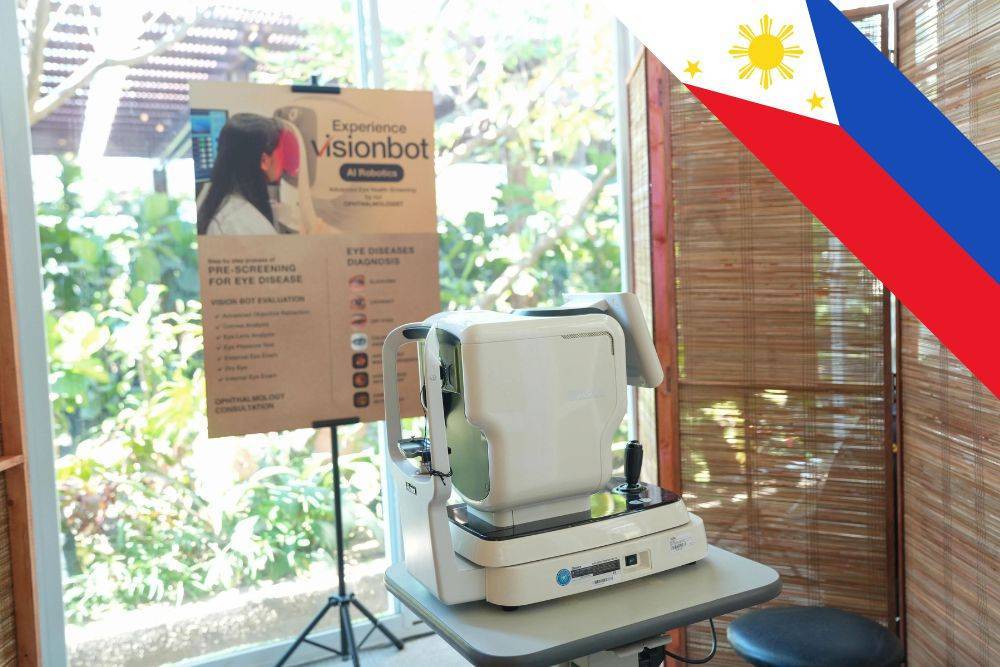The Philippines has recently introduced a groundbreaking AI eye robot capable of detecting diseases that extend beyond traditional ocular conditions.
This innovative technology, developed in collaboration with Vision Express, was unveiled at the “Summer Solstice” launch in Rockwell, Makati City. The AI-driven tool signifies an advancement in healthcare by leveraging ocular imaging to diagnose systemic health issues.
Detecting Systemic Diseases
The AI eye robot utilizes advanced imaging techniques, including optical coherence tomography (OCT), to analyse retinal images with remarkable precision. This technology can identify major cardiovascular risk factors directly from retinal images. These include age, gender, blood pressure, and smoking status. This capability is particularly revolutionary as it allows for non-invasive, efficient, and accurate health assessments.
Cardiovascular Health
AI analysis of retinal images can reveal significant cardiovascular conditions. For example, hypertension and atherosclerosis, detectable through changes in the retinal blood vessels, can be identified early. The AI technology’s ability to predict cardiovascular events by analyzing ocular biomarkers highlights its potential in preventive healthcare. Researchers have developed AI systems that can detect hypertension with high accuracy. This showcases the potential to predict and manage cardiovascular diseases effectively.
Metabolic Disorders
The AI eye robot can also detect metabolic disorders such as diabetes. By identifying diabetic retinopathy—a condition characterized by damage to the blood vessels in the retina—the robot can facilitate early intervention. This can also help prevent complications like vision loss and improve overall disease management. Diabetic retinopathy is a common complication of diabetes, and early detection through AI can significantly enhance patient outcomes.
Neurological Insights
The eye, often referred to as the “window to the soul,” shares many characteristics with the central nervous system. This AI technology can detect neurological conditions such as Parkinson’s disease and Alzheimer’s disease by examining changes in the retina. For instance, retinal thinning and alterations in retinal ganglion cells can indicate Parkinson’s disease, while specific protein deposits in the retina can signify Alzheimer’s.
Alzheimer’s Disease
The AI system can identify biomarkers associated with Alzheimer’s disease, such as beta-amyloid and tau proteins in the retina. These biomarkers are crucial for early diagnosis, which is essential for effective management and potential slowing of disease progression. Studies have shown that retinal thickness correlates with Alzheimer’s, making OCT an effective tool for early screening. By identifying these changes early, the AI robot can facilitate timely intervention and potentially slow disease progression.
Parkinson’s Disease
For Parkinson’s disease, the AI robot can detect retinal changes indicative of the disease, such as the thinning of the retinal nerve fiber layer. This capability provides a noninvasive method to screen for Parkinson’s, potentially leading to earlier diagnosis and better patient outcomes. The integration of AI in detecting such subtle changes underscores its potential to revolutionise the diagnosis and management of neurological diseases.
Early Diagnosis and Treatment
One of the most significant advantages of this AI eye robot is its ability to provide early diagnosis of various conditions, allowing for timely intervention. Early detection is crucial for diseases like age-related macular degeneration (ARMD) and diabetic retinopathy. In these conditions, early intervention can significantly impact treatment outcomes. The AI robot’s precision in identifying early signs of these conditions can lead to better management and improved patient quality of life
Accessibility and Efficiency
The AI eye robot’s capability to perform detailed analyses quickly and without the need for specialist interpretation democratizes access to advanced diagnostic tools. This is particularly beneficial in regions with limited access to healthcare specialists, enabling broader and more equitable healthcare delivery.
Future Implications
The introduction of this AI eye robot in the Philippines marks a pivotal step in integrating artificial intelligence into everyday healthcare practices. By continuously improving its algorithms with large datasets, this technology promises to enhance the accuracy and range of detectable conditions. The AI robot’s ability to learn and adapt from vast amounts of data can lead to the development of even more precise diagnostic tools.
Expanding AI Capabilities
As AI technology evolves, the potential applications of the AI eye robot could expand further. Future developments may include enhanced predictive models for a broader range of diseases, integration with other diagnostic tools, and improved algorithms that offer even greater accuracy and reliability. The continuous improvement and adaptation of AI systems can lead to more comprehensive healthcare solutions, addressing a wider array of medical conditions with unprecedented precision.
Photo Credit: Vision Express
Have a pressing question for a doctor? Medical Channel Asia has launched a community forum page where you can get questions answered by a medical specialist. Visit the community forum here.

